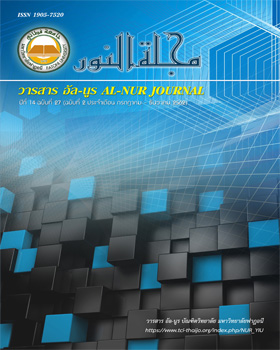การจัดการเชิงกลยุทธ์ของธุรกิจเต็นท์รถยนต์มือสองในพื้นที่จังหวัดยะลา
คำสำคัญ:
การจัดการกลยุทธ์, รถยนต์มือสอง, สภาพแวดล้อมภายในภายนอกบทคัดย่อ
การศึกษาครั้งนี้มีวัตถุประสงค์เพื่อ (1) สร้าง Business Model Canvas ของ การจัดการเชิงกลยุทธ์ของธุรกิจเต็นท์รถยนต์มือสองในพื้นที่จังหวัดยะลา (2) วิเคราะห์จุดแข็ง จุดอ่อน โอกาส และอุปสรรค ที่ส่งผลต่อ การจัดการเชิงกลยุทธ์ของธุรกิจเต็นท์รถยนต์มือสองในพื้นที่จังหวัดยะลา (3) หาแนวทางการจัดการเชิงกลยุทธ์ของธุรกิจเต็นท์รถยนต์มือสองในพื้นที่จังหวัดยะลา สำหรับผู้ประกอบการ ผู้บริโภค และผู้ที่เกี่ยวข้อง
ผลการศึกษาพบว่า
- Business Model Canvas ของของธุรกิจเต็นท์รถยนต์มือสองในพื้นที่อำเภอเมือง จังหวัดยะลา จากการศึกษา พบว่า 1) กลุ่มลูกค้า (Customer Segment) ได้แก่ ผู้บริโภคที่อาศัยอยู่ในพื้นที่จังหวัดยะลา และจังหวัดใกล้เคียง มีอาชีพเป็นข้าราชการ พนักงานรัฐวิสาหกิจ และธุรกิจส่วนตัว มีอายุตั้งแต่ 30 ปีขึ้นไป 2) คุณค่าสินค้า/บริการ (Value Propositions) ได้แก่ รถยนต์สภาพดี ไม่เฉี่ยว ไม่ชน ให้ข้อมูลที่ตรงไปตรงมา บริการที่ประทับใจ ความสะดวกสบาย 3) ช่องทางการเข้าถึงลูกค้า (Channels) คือ การบอกต่อปากต่อปาก โซเชียลมีเดีย เครือข่ายนายหน้าขายรถ โฆษณาผ่านสื่อวิทยุ ป้ายโฆษณา แผ่นพับ ใบปลิว 4) ความสัมพันธ์กับลูกค้า (Customer Relationships) ได้แก่ การจัดโปรโมชั่น การให้บริการที่ดีได้มาตรฐานและบริการอย่างมือชีพ การให้คำแนะนำปรึกษาด้านการจัดไฟแนนซ์ และบริการโอน ย้าย call center 5) รายได้หลัก (Revenue Streams) ได้จากการจำหน่ายรถยนต์มือสองทุกยี่ห้อ การจดทะเบียน พรบ. ประกันภัยรถยนต์ เป็นต้น 6) ทรัพยากรหลัก (Key Resources) ได้แก่ อาคารสถานที่ ทรัพยากรทุน พนักงานขาย 7) กิจกรรมหลัก (Key Activities) คือบริการที่ครบวงจร มีบริการหลังการขาย จัดงานอีเว้นท์ในงานของจังหวัด 8)พันธมิตร (Key Partners) ได้แก่ บริษัทประกัน บริษัทรับจัดไฟแนนซ์ และ 9) โครงสร้างต้นทุน (Cost Structure) ได้แก่ เงินเดือนพนักงานขาย ค่าเช่า ค่าสาธารณูปโภค ค่าน้ำมันเชื้อเพลิง ค่าบำรุงรักษา โบนัสพนักงานขาย ค่าใช้จ่ายในการขาย เบ็ดเตล็ดอื่นๆ
- จุดแข็งของธุรกิจเต็นท์รถยนต์มือสองในพื้นที่อำเภอเมือง จังหวัดยะลา จากการศึกษาพบว่า ธุรกิจเต็นท์รถยนต์มือสองมีเครือข่ายพันธมิตรทั้งทางตรงและทางอ้อม เช่น ไฟแนนซ์ อู่ซ่อม
รถ เป็นต้น มีบริการ m-pay และจัดไฟแนนซ์ ครบวงจร พนักงานมีประสบการณ์และมีความเชี่ยวชาญด้านการบริการ จนทำให้มียอดขายเป็นอันดับ 1 ลูกค้าสามารถเข้าถึงข้อมูลได้โดยผ่านโซเชียล มีเดีย เครือข่ายนายหน้าขายรถ และโฆษณาผ่านสื่อวิทยุ ทำเลที่ตั้งใกล้กับย่านการค้า และสะดวกต่อการเดินทาง มีการปรับปรุงโปรโมชั่นอยู่เสมอ มีธุรกิจมีสภาพคล่องในการดำเนินงาน
- จุดอ่อนของธุรกิจเต็นท์รถยนต์มือสองในพื้นที่อำเภอเมือง จังหวัดยะลา จากการศึกษาพบว่า เครือข่ายนายหน้ายังไม่คลอบคลุมทุกพื้นที่ ขาดประสบการณ์ เพราะเครือข่ายนายหน้า มีส่วนสำคัญในการจำหน่ายรถยนต์ หากเครือข่ายนายหน้ามีความเข้มแข็งจะทำให้ ธุรกิจสามารถระบายรถหรือ จำหน่ายรถได้รวดเร็วขึ้น การเปิดธุรกิจเต็นท์รถยนต์มือสองต้องใช้ระยะเวลายาวนานเพื่อจะได้เป็นที่รู้จักสำหรับผู้บริโภคและแหล่งคัดเลือกรถยนต์มือสองอยู่แถวภาคกลาง มีระยะทางที่ไกล ซึ่งระยะทางในการเคลื่อนย้ายรถยิ่งไกลเท่าไหร่ ก็จะสิ่งเสียค่าใช้จ่ายในการเคลื่อนย้ายมากขึ้น
- โอกาสของธุรกิจเต็นท์รถยนต์มือสองในพื้นที่อำเภอเมือง จังหวัดยะลา จากการศึกษาพบว่า ลูกค้ากลุ่มเป้าหมายส่วนใหญ่เป็นมุสลิมและเป็นข้าราชการ ซึ่งในพื้นที่สามจังหวัดชายแดนภาคใต้มีประชากรที่เป็นมุสลิมเป็นจำนวนมาก มีเจ้าหน้าที่จากบริษัทจัดไฟแนนซ์มาคอยให้บริการที่ร้านทุกวันลูกค้าสามารถขอคำปรึกษา คำแนะนำจากเจ้าหน้าที่จัดไฟแนนซ์ได้โดยตรง มีบริการขอสินเชื่อให้กับลูกค้าโดยจะจัดไฟแนนซ์ให้ฟรี ไม่เสียค่าบริการ เพื่อความรวดเร็วในการขอสินเชื่อฟรีค่าโอนกรรมสิทธิ์รถยนต์ นอกจากนี้ยังฟรีภาษี ฟรี พ.ร.บ และทำเลที่ตั้งของธุรกิจเต็นท์รถยนต์มือสอง อยู่ในย่านการค้า สามารถเข้าถึงผู้บริโภคที่หลากหลาย
- อุปสรรคของธุรกิจเต็นท์รถยนต์มือสองในพื้นที่อำเภอเมือง จังหวัดยะลา จากการศึกษาพบว่า เศรษฐกิจตกต่ำ กำลังซื้อน้อยลงเนื่องจากราคายางตกต่ำ ความเจริญเติบโต ทางเศรษฐกิจลดลง ภาวะการค้าเริ่มซบเซา สินค้าขายได้น้อยลง ทำให้ผู้ประกอบการทั้งหลายเริ่มลดการผลิตลง
เนื่องจาก ขาดทุน ผลที่ตามมาก็คือมีการเลิกจ้างแรงงาน ใช้ทรัพยากรและปัจจัยในการผลิตลดลง อำนาจซื้อของประชาชนน้อยลงนอกจากนี้ยังมีเครดิตของผู้บริโภค ทำให้ขอสินค้าไม่ผ่านเงื่อนไขของบริษัทไฟแนนซ์ ทำให้ไม่สามารถซื้อรถยนต์มือจากเต็นท์ได้ และมีคู่แข่งรายใหม่ โดยการเปิดใหม่เพิ่มเป็นจำนวนมาก
- TOWS Matrix ของธุรกิจเต็นท์รถยนต์มือสองในพื้นที่อำเภอเมือง จังหวัดยะลา จากการศึกษา พบว่า กลยุทธ์ SO ได้แก่ ขยายตลาดไปยังมุสลิม และข้าราชการ ประชาสัมพันธ์เพื่อรองรับลูกค้าใหม่ๆ ผ่านทางช่องทาง ที่หลากหลาย กลยุทธ์ WO ได้แก่ เพิ่มเครือข่ายนายหน้า ทำเลที่ตั้งเหมาะสม การสัญจรไปมาสะดวกเพิ่มโอกาสในการขายได้มากขึ้น กลยุทธ์ ST ได้แก่ เพิ่มประสิทธิภาพด้านคุณภาพรถและคุณภาพการบริการ และกลยุทธ์ WT ได้แก่ สร้างความสัมพันธ์อันดีกับนายหน้า
- การวางแผนกลยุทธ์หรือแนวทางในการจัดการเชิงกลยุทธ์ของธุรกิจเต็นท์รถยนต์มือสองในพื้นที่จังหวัดยะลา การวางกลยุทธ์ระดับองค์กร ใช้กลยุทธ์เชิงรุกคือการเพิ่มเครือข่ายนายหน้า ส่วนกลยุทธ์ระดับธุรกิจ ใช้กลยุทธ์เพิ่มประสิทธิภาพด้านคุณภาพรถและคุณภาพการบริการ และกลยุทธ์สร้างความสัมพันธ์อันดีกับนายหน้า
คำสำคัญ : การจัดการกลยุทธ์, รถยนต์มือสอง, สภาพแวดล้อมภายในภายนอก
เอกสารอ้างอิง
กรวิภา สุทธิ.(2558). แนวทางการจัดการขยะมูลฝอยขององค์การบริหารส่วนตาบลเนินเพิ่ม อาเภอนครไทย จังหวัดพิษณุโลก. วิทยานิพนธ์: ศิลปศาสตรมหาบัณฑิต สาขานโยบายสาธารณะ มหาวิทยาลัยราชภัฏเลย.
กุลกัญญา บุษปะบุตร. (2556). ปัจจัยที่มีความสัมพันธ์กับการตัดสินใจซื้อรถยนต์นั่งส่วนบุคคลของผู้บริโภคในเขตกรุงเทพมหานคร. วิทยานิพนธ์เศรษฐศาสตรมหาบัณฑิต : มหาวิทยาลัยศรีนครินทรวิโรฒ.
จตุพร สังขวรรณ. (2557). ภาวะผู้นำเชิงกลยุทธ์. กรุงเทพฯ : ซีเอ็ดยุเคชั่น.
จตุพร สังขวรรณ. (2557). ภาวะผู้นำเชิงกลยุทธ์ (Strategic Leader).กรุงเทพฯ : ซีเอ็ดยูเคชั่น
จังหวัดยะลา. (2559). ข้อมูลทั่วไปจังหวัดยะลา. [online]. เข้าถึงได้จาก http://www.osmsouth เมื่อวันที่ 15 ตุลาคม พ.ศ. 2560
ฐานเศรษฐกิจ. (2559). ตลาดรถยนต์ปี 2559. [online] เข้าถึงได้จาก http://www.thansettakij.com/content/24088 เมื่อวันที่ 15 ตุลาคม พ.ศ. 2560
ฐาปนา ฉิ่นไพศาล. (2560). การจัดการเชิงกลยุทธ์. กรุงเทพฯ : ธนธัชการพิมพ์ จำกัด.
ณัฎฐพันธ์ เขจรนันทน์ .(2559). กลยุทธ์การสร้างองค์กรคุณภาพ . กรุงเทพฯ : ธรรมกมลการพิมพ์.
ณัฐนัย ตรีเนตรสัมพันธ์ และสุทัศน์ รัตนเกื้อกังวาน. (2559). การพัฒนาโมเดลธุรกิจด้วยวิธีการลีนสตาร์ทอัพ. กรุงเทพ : วารสารวิจัยและพัฒนา มจธ. ปีที่ 39 ฉบับที่ 3 กรกฎาคม – กันยายน 2559.
ดุษฎี นาคเรือง. (2557). การจัดการเชิงกลยุทธ์. ยะลา : มหาวิทยาลัยราชภัฏยะลา
ธวัชชัย พืชผล. (2557). ธุรกิจเราเอาไงดี. กรุงเทพฯ : เลิฟแอนด์วิพเพรส.
นพรัตน์ ภูมิวุฒิสาร. (2556). การจัดการการตลาด. กรุงเทพฯ : จุฬาลงกรณ์มหาวิทยาลัย.
บุญฑวรรณ วิงวอน. (2556). การเป็นผู้ประกอบการยุคโลกาภิวัตน์. พิมพ์ครั้งที่ 1. ม.ป.ท. : แอททีฟพริ้นท์.



